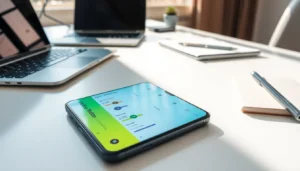In a world where screens are practically glued to our hands, Apple’s Screen Time feature is like that friend who reminds you to take a break from binge-watching cat videos. It’s not just about limiting screen time; it’s about reclaiming those precious hours for hobbies, family, or maybe even a walk outside—remember those?
With a few taps, users can track their daily usage, set app limits, and even schedule downtime. It’s like having a personal trainer for your digital habits, minus the sweat and the gym membership. Whether you’re a tech-savvy guru or just trying to figure out why your phone keeps buzzing, understanding Screen Time can help create a healthier relationship with technology. So, let’s dive into how this nifty feature can transform screen time from a guilty pleasure into a balanced part of life.
Table of Contents
ToggleOverview of Screen Time Apple
Apple’s Screen Time feature assists users in managing their digital habits effectively. This tool enables individuals to track daily screen usage, set app limits, and schedule downtime.
What Is Screen Time?
Screen Time provides insights into how much time users spend on their devices. It aggregates data from various apps, offering a comprehensive view of daily and weekly usage. Users can access this information easily through the Settings app on their Apple devices. Notifications highlight excessive usage, allowing for proactive adjustments to habits. This feature also supports family sharing, letting parents monitor children’s device activity. With Screen Time, users gain awareness of their digital habits, enhancing self-regulation and promoting healthier device interactions.
Importance of Screen Time Management
Managing screen time is crucial for overall well-being. Excessive device usage has been linked to issues such as decreased focus, enhanced anxiety, and disrupted sleep patterns. Fostering a balanced relationship with technology leads to increased productivity and better mental health. Setting app limits encourages users to engage in offline activities, strengthening connections with family and friends. Screen Time also encourages mindfulness in device usage, prompting individuals to reflect on their habits regularly. Prioritizing screen time management ultimately enhances life quality, allowing individuals to utilize their time more meaningfully.
Features of Screen Time Apple
Screen Time offers various features to help users monitor and manage their device usage effectively. These tools foster healthier habits and enhance overall well-being.
App Limits
App Limits allow users to set restrictions on app usage. By defining specific time constraints, users can ensure they spend no more than a set limit on certain apps each day. Notifications help warn users when they’re close to reaching their limits, promoting awareness of overall usage. Parents can establish limits for their children’s apps, further facilitating a balanced digital experience. The flexibility in customizing these limits caters to personal needs and priorities.
Downtime
Downtime enables users to schedule periods without app access. During these times, only phone calls and specific apps can be used, encouraging breaks from screens. Users can set daily Downtime schedules based on their routines, creating intentional opportunities for offline activities. This functionality helps reduce distractions during critical times, such as family meals or bedtime. Adopting a regular Downtime schedule also contributes to improved sleep hygiene and mental well-being.
Content & Privacy Restrictions
Content & Privacy Restrictions help users maintain control over their digital environments. Users can easily limit access to specific content types, such as adult websites or inappropriate apps. Privacy settings enhance security by allowing users to manage location sharing and data access for individual apps. Families can implement these restrictions to tailor device usage for children, creating a safer online space. Customizable settings ensure that each user’s needs are met while maintaining a focus on digital safety and well-being.
Benefits of Using Screen Time on Apple Devices
Screen Time on Apple devices offers several benefits that enhance user experience and promote healthier digital habits. It empowers users with tools to manage their technology usage effectively.
Enhanced Productivity
Enhanced productivity stands out as one of the primary advantages of using Screen Time. Users gain visibility into their app usage patterns. Tracking daily screen time encourages individuals to identify distractions and limit time on less productive applications. Setting app limits fosters a more focused work environment, as notifications signal when it’s time to take a break. Consequently, users often find that they’d accomplish more tasks when they allocate specific time slots for each app or activity. Prioritizing work over recreational screen time leads to better time management and reduces procrastination.
Improved Family Communication
Improved family communication forms another key benefit of Screen Time. Families can use this feature to foster open dialogue about digital habits. By monitoring app usage, parents gain insights into their children’s online activities, promoting discussions about appropriate screen time. Setting shared app limits encourages family members to engage in offline activities together. Downtime scheduling also provides a regular opportunity for family bonding without device distractions. As a result, maintaining healthy communication patterns and shared experiences can significantly strengthen family relationships.
Drawbacks of Screen Time Apple
Screen Time Apple offers users the ability to manage their device usage effectively. However, it comes with several drawbacks that can hinder its effectiveness.
Potential for Over-Restriction
Over-restrictive settings can lead to significant frustration for users. When individuals set stringent app limits, they may find themselves unable to access essential tools for work or communication. Many users experience stress when their workflow is interrupted by notifications that signal a screen time limit has been reached. This interruption can decrease productivity and lead to feelings of resentment toward the technology designed to help. Some individuals may react by disabling the feature entirely, undermining the original goal of promoting healthier habits.
User Resistance
User resistance often occurs when individuals perceive Screen Time as intrusive. Many may feel that restrictions limit their autonomy over personal device usage. Younger users, especially, might push back against parental controls, leading to conflicts or secretive behavior regarding app usage. Trust is crucial in these dynamics; when Screen Time feels like a policing mechanism rather than a supportive tool, it can damage family relationships. Many users strive for balance but resist imposed limits, preferring self-regulation over enforced restrictions.
Apple’s Screen Time feature serves as a valuable ally in the quest for digital balance. By offering tools to track usage and set limits, it empowers users to take control of their screen habits. This capability not only enhances productivity but also fosters healthier family dynamics through open communication about technology use.
While challenges like user resistance and over-restrictive settings exist, the potential benefits of mindful screen management far outweigh these concerns. Embracing Screen Time can lead to improved well-being and a more fulfilling life beyond screens. As users navigate their digital environments, this feature stands as a reminder that technology should enrich life rather than detract from it.

